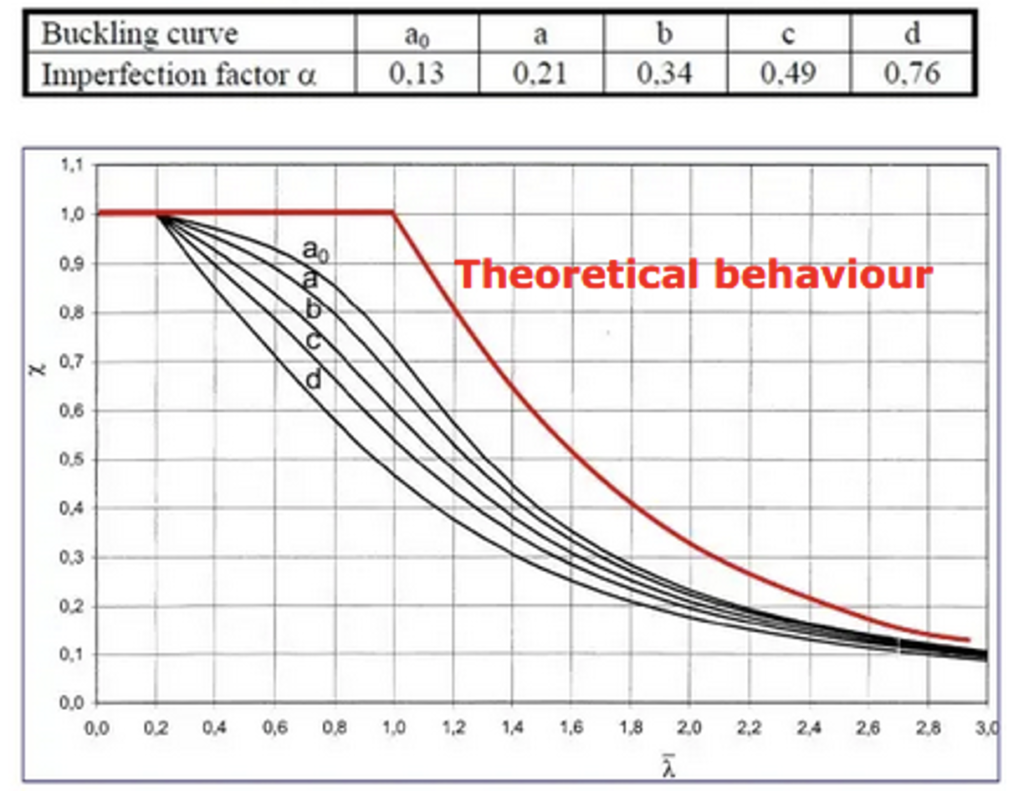How can the axial load-carrying capacity of a steel column be determined?
Following on from our previous article on evaluating the Euler buckling load, we’re going to look at some other calculations we need when looking at buckling of columns.
Eccentrically loaded steel column design.
The axial force can’t act centrically on the column, so, in addition, the column is always exposed to bending. As a result of the action of the bending moment, there is a further increase in the bending moment.
For the design of eccentrically loaded steel columns, the following conditions must be met:
NEdNcr,Nc,Rd +MEdMRd<1
Where:
- MEd=NEd x e
- e – eccentricity (m)
- MRd – design resistance bending moment, MRd=W·fyM0 (kNm).
Euler critical buckling force is defined as: Ncr=2EILe2
The Euler critical buckling force is defined as:
Ncr=2EILe2
Take a 3-meter-long column with one end pinned and the other fixed. It has a cross-section area of A = 3.125 x 10-3 m2, moment of inertia of I = 4.7526 x 10-5 m4, and a width of 2.20 x 10-4 m3. Column is loaded with NEd = 150 kN at eccentricity of e = 0.02 m.
We’re going to calculate the axial force and bending moment interaction for steel grade S235 and E = 210 x 109 Pa.
Nc,Rd=A x fyM0=0.003125 mm2 x 235 MPa1.1=667.6 kN
Le=K x L = 0.7 x 3.0m = 2.1m.
Ncr=2EILe2=9.86 x 210 x 109 Pa x 4.7526 x 10-52.12=223.14 kN
MEd=150 kN 0.02m=3.0 kNm
MRd=W x fyM0=2.2 x 10-4 m3 x 235 MPa1.1=47.0 kNm
NEdNcr,Nc,Rd +MEdMRd=150 kN223.14 kN+3.0 kNm47.0 kNm=0.67+0.064=0.734<1
The axial load carrying capacity of real columns.
Due to various imperfections of real steel columns, failure due to inelastic buckling occurs before the Euler buckling force. The procedure for determining the buckling load-bearing capacity of a real steel column consists of several steps:
- column plastic resistance calculation,
- column effective length determination,
- slenderness λ determination,
- slenderness λ1 determination,
- non-dimensional slenderness determination,
- buckling curve determination,
- reduction factor χ determination,
- column buckling load-bearing capacity calculation.
To consider geometric and material imperfections, dimensionless buckling curves were defined. The figure below shows dimensionless buckling curves.


Except for buckling curves, the reduction buckling factor (χ) can be calculated by the following expression:
χ=1ɸ+ɸ2-2<1.0
Where are:
ɸ=0.5·[1+α·̿-0.2+̿2]
Column buckling resistance (kN) is defined by the following expression:
Nb,Rd=χ x Nc,Rd.
Let’s check out another example. We’ll take another 3m long column with one end pinned and the other fixed. It has a cross-section area A=3.125×10-3 m2 and moment of inertia I=4.75026×10-5 m4. Buckling curve a. Calculate the column buckling resistance for steel grade S235 and E=210 x 109 Pa.
Nc,Rd=A x fyM0=0.003125 m2 x 235 MPa1.1=667.6 kN
Le=K x L=0.7 x 3.0m=2.1m
imin=IA=4.75026 x 10-50.003125=0.039 m
λ=Leimin=2.1m0.039m=53.8
1=π x Efy=3.14 x 210000 x 106 Pa235 x 106 Pa=29.9
=1=53.829.9=1.8
From the diagram above χ = 0.28.
Nb,Rd=χ x Nc,Rd=0.28 x 667.6 kN=186.9 kN
We’re going to finish off our series of buckling calculations in our next article, so be sure to check it out.
Interested in our courses?
Interested in civil or mechanical engineering? Find out more about all the civil engineering courses we have available by clicking here, and the mechanical engineering courses by clicking here.
Diploma in Mechanical Engineering
Diploma in Mechanical Technology
Diploma in Sustainable Construction
Diploma in Structural Engineering
Diploma in Building and Construction Engineering
Higher International Certificate in Civil Engineering
Higher International Diploma in Civil Engineering
Higher International Diploma in Mechanical Engineering
Higher International Certificate in Mechanical Engineering
Alternatively, you can view all our online engineering courses here.
Recent Posts
Understanding and Calculating Generator Efficiency and Output Parameters
Understanding and Calculating Generator Efficiency and Output Parameters Introduction The performance of a generator is often judged by how efficiently it converts mechanical energy into electrical energy. Understanding and calculating this efficiency, along with other key output parameters such as voltage, current, power factor, and load, is essential for evaluating performance and ensuring reliable operation. […]
Essential Cooling and Protection Devices: How They Work and Why They Matter
Essential Cooling and Protection Devices: How They Work and Why They Matter Introduction Generators produce a significant amount of heat and electrical stress during operation, which can affect performance and lifespan if not properly managed. That’s where cooling and protection devices come in. These essential systems, including fans, radiators, circuit breakers, and relays, work together […]
Justifying the Choice of Generators Based on Requirements and Characteristics
Justifying the Choice of Generators Based on Requirements and Characteristics Introduction Selecting the right generator isn’t just about power output, it’s about finding a machine that meets specific operational needs, efficiency goals, and environmental conditions. Different applications demand different generator types, capacities, and features. In this article, we’ll explore how to justify the choice of […]

